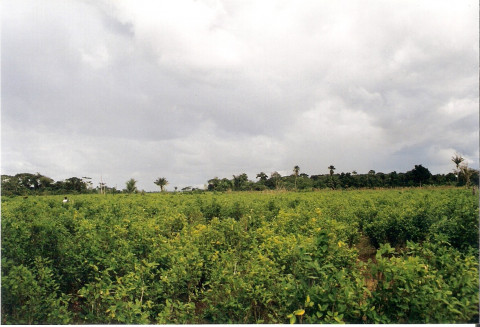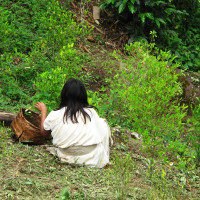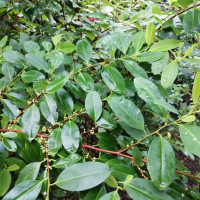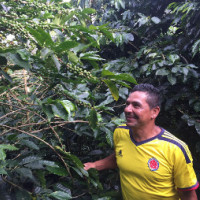Forced Eradication of Crops for Illicit Use and Human Rights
Regions
According to UNODC figures as of December 31, 2019, 154,000 ha of coca were detected in Colombia, which means a reduction of 15,000 ha, that is, 9% less compared to the 169,000 ha detected in 2018. President Duque’s government set a goal of eradicating 130,000 hectares of coca leaf crops during 2020, 62.5 percent more than 2019, when the goal was set at 80,000 ha.

Martin Jelsma
According to UNODC figures1 as of December 31, 2019, 154,000 ha of coca were detected in Colombia, which means a reduction of 15,000 ha, that is, 9% less compared to the 169,000 ha detected in 2018. President Duque’s government set a goal of eradicating 130,000 hectares of coca leaf crops during 2020, 62.5 percent more than 2019, when the goal was set at 80,000 ha.
Main considerations about current supply reduction policies that focus on crops for illicit use
1. Under the current government, there is a total lack of coordination with regard to alternative policies in relation to crops for illicit use, (call it substitution or alternative development) and the strategy of reduction of crops based on forceful actions.
This lack of coordination was already observed during the Santos administration. On the ground and concerning the actions of forced eradication, it has been the Ministry of Defence that has been controlling the implementation of the policy, in open alignment with the demands of the United States of America.2
- Regarding forced eradication, which has become “violent eradication”, a proper State policy has predominated, while in the substitution programs or alternatives to the economy of crops for illegal use, traditional government policy continues.3 Clearly, Colombia’s State policy is drawn up by Washington and is based on the unsuccessful demand for reduction of areas as the substantial aspect, to the detriment of rural development policies or at least strengthening peasant economies.
- The demands of the United States are based on false premises that assign Colombia a responsibility for the serious public health crisis in the US that is associated with the increase in overdose deaths due to the consumption of synthetic opiates and Fentanyl, rather than cocaine. However, the Colombian government rigorously accepts a purported co-responsibility that we condemn as false.4
- The above is part of the complex relationship between security and development or security and strengthening the autonomy processes of indigenous and collective territories towards self-government. That relationship is central in the post-peace agreement scenario and the country is in arrears to assume it. The design of intervention strategies without taking into account that relationship or simply reduce it to the militarization of the territories as the master key to security, goes beyond the participation of the communities in the construction of the civil space that Colombia urgently needs. It implies respecting their autonomous security and protection processes. In the aggravation of insecurity there is a historical and continuous responsibility of the governments that have had or assumed power since the signing of the peace agreement.
2. The Government's narrative on coca farmers
As the official government version of the massacre was that it occurred amid clashes with an illegal armed group, a prosecutor specialized in criminal organizations took the lead over the case. This situation was not accepted by the representatives of the victims who, considering it a massacre perpetrated by state actors, insisted that the investigation should be undertaken by a human rights prosecutor. However, on September 27, 2019 it was announced that the case would go to the military criminal justice department.
Recalling that during the Santos period between 2017 and August 2018, eight people lost their lives amid forced eradication actions, after the recent signing of the peace agreement. Under the Duque administration 4 peasants were killed in these operations.7
Overall, in the areas with presence of crops for illicit use, a series of human rights violations have occurred and the minimum standards of protection for the civilian population provided for in International Humanitarian Law have been breached. For this reason, communities fear that the presence of troops from the Security Forces Assistance Brigade (SFAB), part of bilateral US-cooperation in the fight against drug trafficking, will aggravate the situation. Their presence is announced precisely in areas of military operations of the so-called Future Zones that coincide with territories that have high homicide rates due to forced eradication operations by both the Armed Forces and the Police (See Table). Its support is focused on the Hercules Joint Task Forces (Tumaco, South Pacific), Vulcano (Catatumbo Region), Omega (Meta, Caquetá and Guaviare) and the Drug Trafficking Brigade (National Coverage).
With regard to the cases of killed rural residents, who were involved to some extent in the National Crop Substitution Programme8 (PNIS), part of the peace accords, or who were simply present at the time of the forced eradication operations, the situation was as follows, from June 2020 onwards:
Killings of leaders and persons related to PNIS and/or in context of manual forced eradication operations from November 24 of 2016 to 5 of June 2020 and at the municipal level
|
Department y homicidios pers. relac con PNIS o EMF. |
No. |
Subregión |
No. |
Municipios y homicidios pers. Relac con PNIS o EMF |
No. |
Zonas Futuro (ZEII) |
Contexto tasa de homicidios gral 100 K |
Lugar en el Dpto. |
Tasa Dpto por 100 K |
|
Antioquia |
22 |
Bajo Cauca |
17 |
Tarazá |
14 |
|
233.04 |
2 |
34 |
|
|
|
|
|
Carepa |
1 |
X |
35.68 |
36 |
|
|
|
|
|
|
Caucacia |
1 |
X |
126.16 |
10 |
|
|
|
|
|
|
Anorí |
1 |
X |
135.31 |
6 |
|
|
|
|
Norte Ant. |
5 |
Briceño |
2 |
|
149.89 |
5 |
|
|
|
|
|
|
Ituango |
2 |
X |
306.24 |
1 |
|
|
|
|
|
|
Valdivia |
1 |
X |
133.72 |
9 |
|
|
Cauca |
19 |
Norte del Cauca |
4 |
Caloto |
3 |
|
124.64 |
3 |
37.50 |
|
|
|
|
|
Corinto |
1 |
|
90.62 |
6 |
|
|
|
|
Centro |
4 |
Cajibío |
3 |
|
23.42 |
|
|
|
|
|
|
|
Morales |
1 |
|
22.61 |
|
|
|
|
|
Zona Sur |
9 |
Balboa |
3 |
|
34.34 |
|
|
|
|
|
|
|
Patía (El Bordo) |
1 |
|
110.19 |
5 |
|
|
|
|
|
|
Bolívar |
3 |
|
15.61 |
|
|
|
|
|
|
|
Argelia |
2 |
|
87.42 |
7 |
|
|
|
|
Bota Cauc. |
1 |
Piamonte |
1 |
|
67.23 |
10 |
|
|
|
|
Pacífico |
1 |
Guapi |
1 |
|
6.68 |
|
|
|
Nariño |
16 |
Pacífico Sur |
13 |
Tumaco |
13 |
X |
126.47 |
1 |
23.77 |
|
|
|
Telembí |
1 |
Maguí Payán |
1 |
X |
24.38 |
8 |
|
|
|
|
La Cordillera |
1 |
El Rosario |
1 |
|
20.41 |
10 |
|
|
|
|
Obando |
1 |
Ipiales |
1 |
|
21.58 |
9 |
|
|
Córdoba |
11 |
Sur de Córdoba (San Jorge) |
9 |
San José de Uré |
7 |
X |
216.47 |
1 |
15.49 |
|
|
|
|
|
Montelíbano |
1 |
X |
41.45 |
2 |
|
|
|
|
|
|
Pto Libertador |
1 |
X |
17.19 |
8 |
|
|
|
|
Sur de Córdoba (Alto Sinú) |
2 |
Tierralta |
2 |
X |
4.66 |
23 |
|
|
Putumayo |
6 |
Medio Put. o Piedemonte |
2 |
Puerto Guzmán |
2 |
|
78.61 |
1 |
46.53 |
|
|
|
Bajo Putumayo |
4 |
Orito |
1 |
|
40.81 |
7 |
|
|
|
|
|
|
Puerto Asís |
2 |
|
64.28 |
5 |
|
|
|
|
|
|
Puerto Leguízamo |
1 |
|
65.02 |
4 |
|
|
Valle |
6 |
Pacífico |
4 |
Buenaventura |
4 |
|
22.64 |
36 |
47.81 |
|
|
|
Norte |
2 |
El Dovio |
2 |
|
48.57 |
20 |
|
|
Caquetá |
4 |
Piedemonte |
4 |
Montañita |
2 |
|
120.13 |
1 |
41.51 |
|
|
|
|
|
San José del Fragua |
1 |
|
78.83 |
2 |
|
|
|
|
|
|
Curillo |
1 |
|
76.08 |
3 |
|
|
N de S |
6 |
Catatumbo |
5 |
Tibú |
2 |
X |
247.99 |
1 |
39.17 |
|
|
|
|
|
Sardinata |
2 |
X |
61.96 |
9 |
|
|
|
|
|
|
Hacarí |
1 |
X |
101.29 |
5 |
|
|
|
|
Oriental |
1 |
Cúcuta |
1 |
|
30.20 |
17 |
|
|
Meta |
2 |
Ariari |
2 |
Mapiripán |
1 |
|
53.96 |
1 |
23.80 |
|
|
|
|
|
La Macarena |
1 |
|
50.33 |
3 |
|
|
Bolívar |
2 |
|
|
Cantagallo |
2 |
|
30.87 |
3 |
17.22 |
Own elaboration based on the Marcha Patriotica "Violations of Human Rights in forced eradication operations of crops for illicit use carried out by combined forces of the National Army and the National Police in Colombia.", June 2020; IGAC - DANE - www.todacolombia.com* Población Proyección DANE 2018; Instituto Nacional de Medicina Legal y Ciencias Forenses, FORENSIS 2018, June 2019.
It should be clarified that the fact that a person is related to the PNIS (as a beneficiary or leader) does not in itself explain the cause of the murder. This is because in the territories and in the complexity of local life, there may exist other motives of a political or social order, or simultaneous economic activities that better specify the eventual reasons motivating the murder. However, the data that we have reviewed gives information on the complexity of these territories implying the need for the design of much more specific protection strategies that respond to the particularity of the circumstances.
The main clues provided by this information are:
There are specific areas that condense the highest number of cases. Firstly, the events in Bajo Cauca with 17 cases and those in the North of Antioquia with 5 are significant, 22 in total, representing 23.4% of the national accumulated. In other words, almost a quarter of the cases are found in these territories. Only Tarazá in Bajo Cauca groups 14 cases, that is, approximately 64% of the events in Antioquia. Tarazá ranks second in the murder rate at the departmental level (233.04 per 100,000), which suggests that the deaths in drug trafficking contexts would be part of a complex web of other motivations and that they should be analyzed in detail. However, the scenario takes on an important relevance; the case of Tarazá contrasts with Ituango in the north of Antioquia, while being the municipality with the highest homicide rates (306.24), it only has two cases.
Cases of productive drug trafficking enclaves that do not have significant homicide rates or murders of people involved in that activity in the period under review, are for example: El Naya (Cauca-Valle del Cauca9) and El Charco-Olaya Herrera (Nariño), areas where the PNIS arrangement did not arrive.10
- Forced eradications and false positives with detainees
In addition to cases of human rights violations, including threats to life, there are now indiscriminate arrests of cultivators taking place, as in the case of the El Silencio village in the jurisdiction of Puerto Alvira, municipality of Mapiripán sur del Meta. According to the Ministry of Defense this concerns people with ties to FARC dissidents. However, the Community Action Group (JAC) of the area insists that the people involved are peasants from that area and that they are peaceful people well known to all.11
3. Current Situation: Covid 19 and the cultivation of coca in Colombia
While the majority of the Colombian people are confined to their homes in compliance with quarantine as ordered by President Iván Duque, the campaign against coca has not stopped and the peasants have to leave their homes to confront the eradicators and the militarized security surrounded by it. In this context, reports of human rights violations caused by forced eradication operations have increased dramatically.
Anorí in Antioquia12, Sardinata13 and Cúcuta in Norte de Santander14, Tumaco in Nariño15, El Retorno Guaviare16and Vistahermosa in Meta17have been in the news in the last two months (May and June 2020) for attacks (homicides and injuries) on peasants, indigenous and Afro-Colombian peoples, who grow coca, and who oppose the spraying of their crops carried out by the police, military or contracted civilians. All of these deaths are the result of the use of weapons by State security forces. There have also been people injured and prosecuted. Also, members of the security forces have been injured or have been held by farmers to prevent their crops from being eliminated. The same reports have surfaced in Putumayo, Caquetá, Córdoba, Cauca and Chocó.
How is it operated?
According to the community of the Salto Gloria village in the municipality of El Retorno (Guaviare), the eradication operation carried out early on the morning of Sunday, May 24, began with a helicopter flying over the targeted area that opened fire, apparently as a deterrent, to disperse the peasantry that had gathered before the landing of the uniformed men, however, the shots frightened the community.
Immediately after tear gas shots were fired at the farmers. Despite this, the disembarkation of the troops in order to eliminate the coca bushes - a task that is sometimes carried out with ground spraying of glyphosate and other times uprooting the plants – ended in confrontations with locals, who, armed with sticks, did not allow the extermination of agriculture that they consider their only viable source of basic income in these geographical confines.
A crash occurred immediately. Again there were shots and amid screaming Manuel Ayala, a 62 year old man well known by the population, was injured. A lady with a cell phone filmed the events that were taking place while she shouted half sentences at the policemen who, dressed as soldiers from futuristic movies, chased a man to capture him.18
The reasons for the operations and the responses of the communities
The government justified its actions with the following discourse;
- The involved communities are located in natural parks or other protected areas.
- These families do not pertain to the National Crop Substitution Program (PNIS).
- Coca production in these regions benefits illegal armed groups.
- Coca cultivation brings violence and deforestation, destroys the environment and pollutes the water.
- Peasants protest because they are forced by the illegal armed groups to do so.
- Peasants have options to engage in legal crop production.
The government justified its actions with the following discourse:
For their part, the communities claim “violations of human rights of the peasants, countless injured civilians and soldiers, arrests, and property stolen from the peasants, minors placed at the disposal of the Colombian Institute of Family Welfare, and displacement of the population by apparently legal avenues”. They argue that they live in parks because they had no other options to access land. And they rely on coca for several reasons: lack of state support, lack of infrastructure, and no access to licit markets. Similarly, coca paste is an easily transportable non-perishable good, of good price, ensured market, source of credit, it is a local currency for commercial exchange and the best source of employment compared to other activities19, despite the low prices received by the farmer in the initial phase of this specific production chain. To which is to be added that in these communities collective agreements could have been signed which did not convert into family substitution arrangements or simply the offer of the PNIS Program did not arrive, despite the fact that Point 1 of the peace agreement considered it a priority to resolve the situation of the peasantry in protected areas .
On the other hand, and according to the Foundation Ideas for Peace (FIP) in the first four-month period of 2020, 82 percent of the municipalities that are part of the PNIS (46) had forced eradication operations. Nine of the 13 municipalities where there were incidents are in this group.20 This fact confirms the predominance in the war treatment of the cultivators of illicit use and the total lack of coordination between the security entities and the entities responsible for the substitution programs or productive, social and environmental protection alternatives in the territories with dependence on this economy. Only in June of this year, Hernando Londoño, the director of substitution of the Agency of Territory Renovation (ART), reported that the entity is processing an agreement with the Parks Unit to address the situation of cultivators in those areas21, almost four years after the Peace Agreement was signed.
4. Violation of the protocols of forced eradication or violent eradication and absence of control and monitoring agencies.
5. Risk increase during the pandemic
"The activities of eradication of crops for illicit use, by members of the State security forces and Mobile Groups of Forced Eradication, generate a risk of contagion by COVID-19, significant and impermissible for the health of the members of ethnic peoples, with respect to which there is a scientific consensus”.23
By virtue of this type of consideration, the Office of the Attorney General requested the suspension of the operations.
6. Proposals
Notes:
1 Figures mentioned by the UNODC Director for Colombia, Pierre Lapaque, and Colombian President Ivan Duque, on a press conference held in Bogota, on June 17, 2020,
2 Nevertheless, on the ground there are “unified command posts” (PMUs) that are run by the military and in which personnel of the National Substitution Programme participate. The problem is at the local level , since the Substitution Programme (PNIS) is farm to farm while eradication is territorial. This would become more serious when aerial spraying is implemented.
3 The Duque administration has created a government policy through the activation of a so-called Integrated Intervention of Special Zones (ZEII) or Future Zones with funds from development aid destined to the peace agenda.
4 Ricardo Vargas M.: “El problema de drogas que Estados Unidos no quiere ver”, article published in La Razon Publica, August 14, 2017
5 Revista Semana, “Masacre de El Tandil: dos años después, las investigaciones toman un curso inesperado”, April 10, 2019
6 Ibid.
7 Figures collated from the record kept by the Patriotic March in the report “Violations of Human Rights in operations of forced eradication of crops for illicit use carried out by combined forces of the National Army and the National Police in Colombia.” June 2020. There was another case whose circumstances are not clear to add to this eradication scenario is José Adalberto Torjano, Coordinator of the Peasant Guard in Corinth, with whom he would add 9 cases in the Santos period.
8 One of the results of the Peace Agreement between the guerilla FARC and the government
9 The hydrographic basin of the Naya river, also known as the "Naya region", is located between the Valle and Cauca departments, bordered on the east by the San Vicente hills (3,000 masl) and Naya, (2,650 masl) on the western mountain range; by the west with the Pacific Ocean; by the north with the change of waters of the Yurumanguí and Naya rivers, and by the south with the change of waters of the Naya and San Juan de Micay rivers. It comprises an approximate area of 170,000 hectares. This region is under the jurisdiction of the Municipalities of Buenaventura in the Valley, and López de Micay and Buenos Aires, in Cauca. https://www.prensarural.org/recorre/naya.htm.
10 About production enclaves, see UNODC “Executive Summery Censo Coca 2019”, June 2020. https://www.unodc.org/documents/crop-monitoring/Colombia/Colombia_coca_survey2019_Fact-sheet_ExSum.pdf
11 See Comunidades Construyendo Paz en Colombia, “Ellos son los campesinos detenidos de Mapiripán, Meta”, junio 23 de 2020 https://comunidadesconpaz.wordpress.com/2020/06/23/ellos-son-los-campesinos-detenidos-de-mapiripan-meta/
12 El Tiempo, “Ejército dio su versión sobre campesino muerto en Anorí, Antioquia”, Mayo 23 de 2020. https://www.eltiempo.com/colombia/medellin/campesino-en-anori-fue-asesinado-en-extranas-campesinas-498796
13 Revista Semana, Campesinos denuncian ejecución extrajudicial de un joven en Sardinata 26 de marzo de 2020. https://www.semana.com/nacion/articulo/campesinos-denuncian-ejecucion-extrajudicial-de-un-joven-en-sardinata/659329
14 El Espectador, Colombia 2020, “Un campesino muerto y tres heridos en un operativo de erradicación forzada en Cúcuta”, mayo 8 de 2020. https://www.elespectador.com/colombia2020/pais/un-campesino-muerto-y-tres-heridos-en-un-operativo-de-erradicacion-forzada-en-cucuta-articulo-920075/
15 El Espectador, “Enfrentamientos por erradicación forzada de coca dejan un muerto en Tumaco”, Abril 22 de 2020. https://www.elespectador.com/colombia2020/territorio/enfrentamientos-por-erradicacion-forzada-de-coca-dejan-un-muerto-en-tumaco-articulo-916008/
16 El Tiempo, “Choque entre campesinos y Esmad por erradicación deja un hombre herido”, 26 de mayo de 2020. https://www.eltiempo.com/colombia/otras-ciudades/erradicacion-de-cultivos-en-guaviare-deja-un-campesino-herido-tras-choque-con-el-esmad-499562
17 Vereda Nueva Colombia, región del Guayabero en jurisdicción de Vistahermosa (Meta), RCN Radio, “Campesinos denuncian atropellos de uniformados por erradicación en el Meta”, https://www.rcnradio.com/colombia/llanos/campesinos-denuncian-atropellos-de-uniformados-por-erradicacion-en-el-meta
18 The lady awaited the security forces, with: “the only thing you bring is violence”, “we are not doing anything”, “This video will go to Human Rights, so that they know”. A police officer asks her: “what are you doing with these kids here?, we will take them to Family Welfare!”. The farmers women responds that the children are nourished thanks to the coca that you are destroying, “what are they going to eat now?”. See video El Tiempo “Choque entre campesinos y ESMAD por erradicación deja un hombre herido”, mayo 26 de 2020. https://www.eltiempo.com/colombia/otras-ciudades/erradicacion-de-cultivos-en-guaviare-deja-un-campesino-herido-tras-choque-con-el-esmad-499562 y https://twitter.com/ColombiaET/status/1265315557227839488?ref_src=twsrc%5Etfw%7Ctwcamp%5Etweetembed%7Ctwterm%5E1265315557227839488&ref_url=https%3A%2F%2Fwww.eltiempo.com%2Fcolombia%2Fotras-ciudades%2Ferradicacion-de-cultivos-en-guaviare-deja-un-campesino-herido-tras-choque-con-el-esmad-499562
19 See “estudio de cadena de valor de coca para pasta base de cocaína, estudio de caso en Catatumbo y Sur de Bolívar”, Pedro Arenas y Salomón Majbub, Observatorio de cultivos y cultivadores declarados ilícitos, 2018.
20 Juan Carlos Garzón, FIP “La erradicación forzada no ha aumentado, pero los cultivadores la están pasando mal”, La Silla Llena, 29 de mayo de 2020. https://lasillavacia.com/silla-llena/red-de-la-paz/la-erradicacion-forzada-no-ha-aumentado-los-cultivadores-la-estan-pasando
21 Notes taken by author at the Interinstitutional Round Table summoned by the Villavicencio Environmental and Agrarian Attorney to listen to the communities of the Tinigua, Picachos and Macarena parks, on July 1, 2020. The director of the PNIS reported this without being sure when said approach will begin. The Table was suspended because the peasants withdrew due to the lack of guarantees on access to electricity, internet to be at the meeting and for being photographed by members of the security forces.
22 El Tiempo, “La erradicación de cultivos de matas de coca no ha parado en Colombia”, Abril 22 de 2020. https://www.eltiempo.com/justicia/conflicto-y-narcotrafico/coronavirus-continuan-las-labores-de-erradicacion-de-coca-en-colombia-487318
23 Attorney Generals’ Office of the Nation. Ethnic Affairs Delegate. Communication to the Ministry of Health of April 28, 2020 in response to the request for suspension authorization of forced eradication of crops for illicit use.




